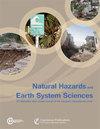Modelling extreme water levels using intertidal topography and bathymetry derived from multispectral satellite images
IF 4.7
2区 地球科学
Q1 GEOSCIENCES, MULTIDISCIPLINARY
引用次数: 0
Abstract
Abstract. Topographic and bathymetric data are essential for accurate predictions of flooding in estuaries because water depth and elevation data are fundamental components of the shallow-water hydrodynamic equations used in models for storm surges and tides. Where lidar or in situ acoustic surveys are unavailable, recent efforts have centred on using satellite-derived bathymetry (SDB) and satellite-derived topography (SDT). This work is aimed at (1) determining the accuracy of SDT and (2) assessing the suitability of the SDT and SDB for extreme water level modelling of estuaries. The SDT was created by extracting the waterline as it tracks over the topography with changing tides. The method was applied to four different estuaries in Aotearoa / New Zealand: Whitianga, Maketū, Ōhiwa and Tauranga harbours. Results show that the waterline method provides similar topography to the lidar with a root-mean-square error equal to 0.2 m, and it is slightly improved when two correction methods are applied to the topography derivations: the removal of statistical bias (0.02 m improvement) and hydrodynamic modelling correction of waterline elevation (0.01 m improvement). The use of SDT in numerical simulations of surge levels was assessed for Tauranga Harbour in eight different simulation scenarios. Each scenario explored different ways of incorporating the SDT to replace the topographic data collected using non-satellite survey methods. In addition, one of these scenarios combined SDT (for intertidal zones) and SDB (for subtidal bathymetry), so only satellite information is used in surge modelling. The latter SDB is derived using the well-known ratio–log method. For Tauranga Harbour, using SDT and SDB in hydrodynamic models does not result in significant differences in predicting high water levels when compared with the scenario modelled using surveyed bathymetry.利用多光谱卫星图像衍生的潮间带地形和测深技术模拟极端水位
摘要地形和水深数据对于河口洪水的准确预测至关重要,因为水深和高程数据是风暴潮和潮汐模型中使用的浅水水动力方程的基本组成部分。在无法使用激光雷达或原位声学测量的情况下,最近的工作集中在使用卫星衍生测深(SDB)和卫星衍生地形(SDT)。本研究的目的是:(1)确定SDT的精度;(2)评估SDT和SDB在河口极端水位模拟中的适用性。SDT是通过提取随潮汐变化的地形水线而创建的。该方法应用于新西兰奥特罗阿的四个不同的河口:Whitianga、maketya、Ōhiwa和Tauranga港口。结果表明,水线法提供的地形与激光雷达相似,均方根误差为0.2 m,地形导数采用两种校正方法:消除统计偏差(改善0.02 m)和水线高程水动力建模校正(改善0.01 m),地形导数略有改善。在8种不同的模拟情景下,评估了SDT在陶朗加港浪涌水位数值模拟中的应用。每个方案都探索了不同的方法,将SDT纳入替代使用非卫星测量方法收集的地形数据。此外,其中一种情景结合了SDT(用于潮间带)和SDB(用于潮下测深),因此在浪涌模拟中只使用卫星信息。后者的SDB是用众所周知的比率-对数方法推导出来的。对于陶朗加港,在水动力模型中使用SDT和SDB与使用测量水深模型模拟的情景相比,在预测高水位方面没有显著差异。
本文章由计算机程序翻译,如有差异,请以英文原文为准。
求助全文
约1分钟内获得全文
求助全文
来源期刊
CiteScore
7.60
自引率
6.50%
发文量
192
审稿时长
3.8 months
期刊介绍:
Natural Hazards and Earth System Sciences (NHESS) is an interdisciplinary and international journal dedicated to the public discussion and open-access publication of high-quality studies and original research on natural hazards and their consequences. Embracing a holistic Earth system science approach, NHESS serves a wide and diverse community of research scientists, practitioners, and decision makers concerned with detection of natural hazards, monitoring and modelling, vulnerability and risk assessment, and the design and implementation of mitigation and adaptation strategies, including economical, societal, and educational aspects.

 求助内容:
求助内容: 应助结果提醒方式:
应助结果提醒方式:


